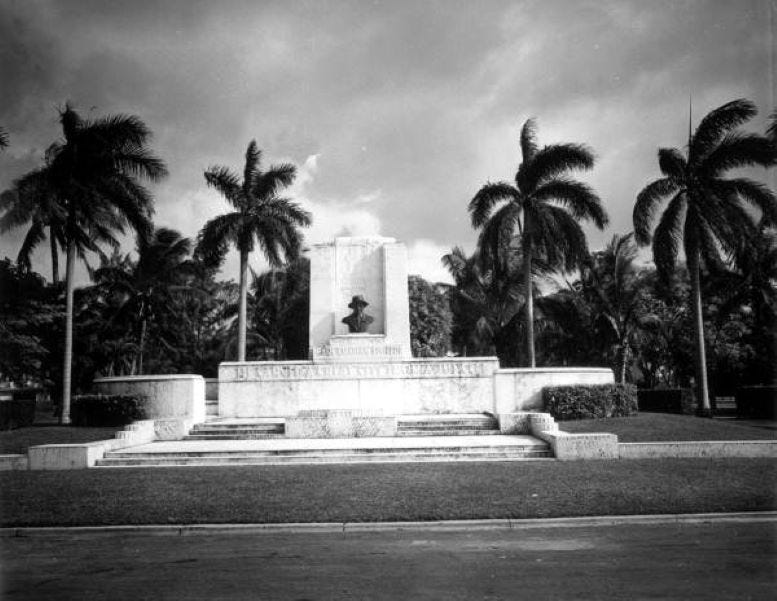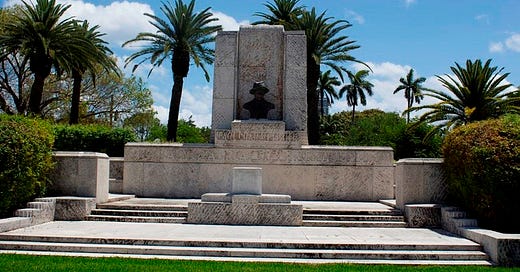Carl Fisher Memorial Dedicated in 1941
The City of Miami Beach dedicated the Carl Fisher Memorial on April 10, 1941. This granite statue still stands at near the intersection of Alton Road and Lakeview Drive.
On April 10, 1941, Miami Beach citizens dedicated a memorial that commemorates the accomplishments of founding father Carl G. Fisher. The memorial features a bronze bust of Fisher, wearing his floppy hat while smiling. The inscription reads: "Carl Graham Fisher - he carved a great city out of a jungle". The memorial is located at the corner of Alton Road and Lakeview Drive.
The dedication ceremony took place in the early evening on Thursday, April 10th, where Carl Fisher’s good friend, James Cox, the owner and editor of the Miami Daily News, gave a speech to dedicate the monument. During this ceremony, Cox declared:
“This granite shaft will stand against the elements through everlasting time, and the memory of Carl Fisher.”
Fisher passed away in St. Francis Hospital on July 15, 1939, after battling years of poor health due to complications from alcoholism. In addition to being a founding pioneer of Miami Beach, he was responsible for building a number of institutions including the Presto-Lite Corporation, along with partner and fellow Miami Beach pioneer James Allision, which was sold to Union Carbide for $9 million in 1910. He was also a founder and builder of the Indianapolis Speedway, along with being a big contributor to the construction of the Lincoln and Dixie highways.
Although Fisher was lauded for being an innovator and a builder, he was also remembered for being selective who he would sell land to on Miami Beach during the formative years of the city. While he made exceptions to sell land to some Jewish buyers based on their net worth, the opportunities to own property, or even to stay in a hotel, was restricted to whites only in the areas that were developed by Fisher’s Alton Beach Realty Company.
During the first half of the Twentieth century, hotels on the beach displayed signs that read ‘Gentiles Only,’ restricting Jewish, Black, and other minorities from enjoying what was marketed as “America’s Winter Playground.” Whether based on the sensibilities of the day, or Fisher’s personal preference, Miami Beach practiced many of the Jim Crowe era policies of the deep south. Fisher was not exclusively responsible for this policy, but as a prominent founder of the city, he did nothing to change it.
These restrictions began to loosen by the mid-1930s when wealthy Jewish hotel operators began buying and constructing new inns and apartment houses on the island. However, the black community, while providing a lot of the labor to help build the city and work in the institutions that catered to tourists, was not able to enjoy the amenities of the island until the Civil Rights movement of the 1960s.

Due to the popularity of Miami Beach as a tourist destination, Fisher turned his attention to the development of Montauk on the eastern point of Long Island, New York, in a similar manner as he approached the construction of Miami Beach. While his dream of a northern tourist destination for the wealthy was ambitious, his financial fortunes took a turn beginning with the Great Hurricane of 1926, and then more dramatically with the stock market crash of 1929. The Montauk project went into receivership in 1932, and from that time onward, Fisher lost nearly all of his personal net worth by the time of his death in 1939.
Given all of his different ventures, he is most fondly remembered in South Florida for his contribution to the development of Miami Beach. Just as Henry Flagler is considered the Father of Miami, Carl Fisher is given the same nod as the Father of Miami Beach. If there were going to be only one memorial for Fisher, Miami Beach is a very fitting place for the man that literally carved a resort city out of jungle.
Related Content:
Resources:
Miami News: “Carl G. Fisher Memorial Dedicated”, April 10, 1941.







Your articles are great! Thank you for keeping history alive!